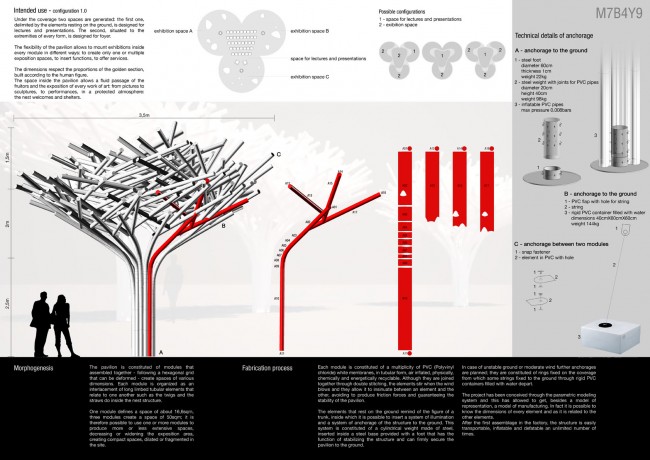Info:
Title: TREES - Code: M7B4Y9Contest: PFFF / 2012
By: P. Renoult, A. Stanghini , V. Van der Horst
Views: 4085 Likes: 9
Votes:
ITALO ROTA0 BENJAMIN BALL10 MARCO CANEVACCI4 VANESSA TODARO6 ANDREA BARTOLI14.2
TREES
Our initial design strategy for the Pavilion established three aims to meet the expectation that the pavilion should become both an exhibition and a public space where its audience could take the time to relax, to observe and then, perhaps, start to create social links. The first aim was to design a pavilion whose architecture allowed total permeability. The second idea was to ensure a significant area of open public space. And thirdly, we were inspired from the static of nest structures, seduced by their chaotic aspect and versatility. Our project is process oriented, and can easily fit a wide range of different contexts: urban, natural, external and internal.
All the project has been design using parametric tools, which enabled us to create both a complex model of representation in 3D and to generate manufacturing datas. All informations concerning the relationship existing between the elements and their dimensions are generated by the algorithm.
The pavilion is constituted of modules that assembled together – following a hexagonal grid that can be deformed – create spaces of various dimensions. Each module is organized as an interlacement of long limbed tubular elements that relate to one another such as the twigs and the straws do inside the nest structure.
One module defines a space of about 16,6sqm, three modules create a space of 50sqm; it is therefore possible to use one or more modules to produce more or less extensive spaces, decreasing or widening the exposition area, creating compact spaces, dilated or fragmented in the site.
We can physically unite several modules through joints that have the form and the function of pressure buttons; or to create single separate exposition islands, through one or more modules, each one provided with a self-supporting structure. This extrovert typology of pavilion guarantees great flexibility of use.
Each module is constituted of a multiplicity of PVC (Polyvinyl chloride) white membranes, in tubular form, air inflated, physically, chemically and energetically recyclable. Although they are joined together through double stitching, the elements stir when the wind blows and they allow it to insinuate between an element and the other, avoiding too much friction forces and guaranteeing the stability of the pavilion.
The pavilion breathes, moves: it is alive.
Under the coverage two spaces are generated: the first one, delimited by the elements resting on the ground, is designed for lectures and presentations. The second, situated to the extremities of every form, is designed for foyer. The flexibility of the pavilion enables us to use every module in a different way: exposition, functional and services areas.
The elements that rest on the ground remind of the figure of a trunk, inside which it is possible to insert a system of illumination and a system of anchorage of the structure to the ground. This system is constituted of a cylindrical weight made of steel, inserted inside a steel base provided with a foot that has the function of stabilizing the structure and can firmly secure the pavilion to the ground.
In case of unstable ground or moderate wind further anchorages are planned; they are constituted of rings fixed on the coverage from which some strings fixed to the ground through rigid PVC containers filled with water depart.
After the first assemblage in the factory, the structure is easily transportable, inflatable and deflatable an unlimited number of times.
The dimensions respect the proportions of the golden section, built according to the human figure.
The space inside the pavilion allows a fluid passage of the fruitors and the exposition of every work of art: from pictures to sculptures, to performances, in a protected atmosphere: the nest welcomes and shelters.
Info:
Title: TREES
Time: 25 gennaio 2012
Category: PFFF
Views: 4085 Likes: 9
Tags: A. Stanghini , Atmospheric pressure , Design , Modules , P. Renoult , Pavilion , Polyvinyl chloride , PVC , Space , Technology , V. van der Horst








